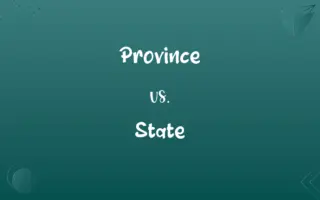Dual Federalism vs. Cooperative Federalism: Know the Difference

By Shumaila Saeed || Published on January 8, 2024
Dual Federalism involves distinct, separate layers of government authority, while Cooperative Federalism features overlapping, interdependent state and federal responsibilities.

Key Differences
Dual Federalism is characterized by clear divisions between national and state governments, each with distinct responsibilities. Cooperative Federalism, on the other hand, blurs these lines, with state and federal governments working collaboratively on various issues.
Shumaila Saeed
Jan 08, 2024
In Dual Federalism, also known as "layer cake" federalism, the federal and state governments operate independently within their spheres. Conversely, Cooperative Federalism, likened to a "marble cake," involves intertwined government functions and policies.
Shumaila Saeed
Jan 08, 2024
Dual Federalism advocates for a stronger distinction in the powers of state and federal governments, limiting their overlap. In contrast, Cooperative Federalism encourages joint efforts and shared functions between the two levels of government.
Shumaila Saeed
Jan 08, 2024
The era of Dual Federalism often saw state and federal governments in limited interaction or cooperation. Cooperative Federalism, emerging later, fostered a more integrated approach, with both levels engaging in collective problem-solving.
Shumaila Saeed
Jan 08, 2024
Dual Federalism typically supports the notion of states’ rights, emphasizing state sovereignty. Cooperative Federalism, however, underscores the importance of collaboration and shared governance for addressing national concerns.
Shumaila Saeed
Jan 08, 2024
ADVERTISEMENT
Comparison Chart
Division of Power
Distinct separation between state and federal roles.
Overlapping state and federal roles.
Shumaila Saeed
Jan 08, 2024
Metaphor
"Layer Cake" – clear, separate layers.
"Marble Cake" – mixed, interwoven layers.
Shumaila Saeed
Jan 08, 2024
Government Interaction
Limited interaction between state and federal governments.
Extensive collaboration between governments.
Shumaila Saeed
Jan 08, 2024
Policy Implementation
Independent policy execution by each government level.
Joint policy execution and shared responsibilities.
Shumaila Saeed
Jan 08, 2024
Historical Period
Predominant in 18th and early 19th centuries.
Emerged in the 20th century, post-New Deal era.
Shumaila Saeed
Jan 08, 2024
ADVERTISEMENT
Dual Federalism and Cooperative Federalism Definitions
Dual Federalism
A federal system emphasizing two levels of government operating independently.
Dual Federalism prevailed in the U.S. until the New Deal era.
Shumaila Saeed
Dec 18, 2023
Cooperative Federalism
A model where state and federal responsibilities are intermingled and cooperative.
Environmental regulations often reflect a Cooperative Federalism approach.
Shumaila Saeed
Dec 18, 2023
Dual Federalism
A federalism type characterized by distinct, non-overlapping governmental powers.
Under Dual Federalism, states independently addressed most internal issues.
Shumaila Saeed
Dec 18, 2023
Cooperative Federalism
A governance style where federal and state entities jointly solve national problems.
Cooperative Federalism has been evident in federal-state partnerships for disaster relief.
Shumaila Saeed
Dec 18, 2023
Dual Federalism
A governance model where federal and state powers are distinctly outlined.
Dual Federalism saw minimal federal intervention in state matters.
Shumaila Saeed
Dec 18, 2023
ADVERTISEMENT
Cooperative Federalism
A federalism type where intertwined governmental powers address collective issues.
Cooperative Federalism is seen in joint federal-state funding for infrastructure projects.
Shumaila Saeed
Dec 18, 2023
Dual Federalism
A system where federal and state governments maintain distinct and separate powers.
The U.S. Constitution initially established a Dual Federalism framework.
Shumaila Saeed
Dec 18, 2023
Cooperative Federalism
A system where federal and state governments share powers and collaborate on policies.
The New Deal era marked the shift towards Cooperative Federalism in the U.S.
Shumaila Saeed
Dec 18, 2023
Dual Federalism
A political arrangement with clearly divided state and national responsibilities.
Dual Federalism was evident in the early interpretation of the Tenth Amendment.
Shumaila Saeed
Dec 18, 2023
Cooperative Federalism
A federal arrangement emphasizing collaboration between different government levels.
Cooperative Federalism was crucial in the implementation of the Affordable Care Act.
Shumaila Saeed
Dec 18, 2023
Repeatedly Asked Queries
What defines Dual Federalism?
Dual Federalism is defined by separate, clearly defined powers for state and federal governments.
Shumaila Saeed
Jan 08, 2024
What are some examples of federal powers under Dual Federalism?
Federal powers typically included foreign affairs, defense, and currency regulation.
Shumaila Saeed
Jan 08, 2024
Does Dual Federalism promote state sovereignty?
Yes, Dual Federalism emphasizes strong state sovereignty within its jurisdiction.
Shumaila Saeed
Jan 08, 2024
What are some examples of state powers under Dual Federalism?
State powers included regulating commerce within state borders and managing local affairs.
Shumaila Saeed
Jan 08, 2024
Is there still a clear separation of powers in Cooperative Federalism?
Cooperative Federalism blurs the lines between federal and state powers, with both levels of government working together on shared policy objectives.
Shumaila Saeed
Jan 08, 2024
What's the essence of Cooperative Federalism?
Cooperative Federalism involves shared powers and collaborative governance between state and federal levels.
Shumaila Saeed
Jan 08, 2024
Can state governments refuse to participate in federal programs under Cooperative Federalism?
While states can choose not to participate in some federal programs, they often participate due to the incentives provided by federal funding.
Shumaila Saeed
Jan 08, 2024
What are some examples of federal-state cooperation in Cooperative Federalism?
Examples include jointly funded programs like Medicaid and educational initiatives.
Shumaila Saeed
Jan 08, 2024
Are there any criticisms of Cooperative Federalism?
Yes, some critics argue that it can lead to excessive federal control and reduced state autonomy in certain policy areas.
Shumaila Saeed
Jan 08, 2024
Was there a lot of cooperation between federal and state governments in Dual Federalism?
No, cooperation was limited in Dual Federalism as each level of government operated within its clearly defined sphere of authority.
Shumaila Saeed
Jan 08, 2024
How does Cooperative Federalism affect the balance of power between federal and state governments?
It can lead to a shift in power towards the federal government due to its ability to influence states through funding and policy mandates.
Shumaila Saeed
Jan 08, 2024
Has Cooperative Federalism resulted in greater flexibility in addressing complex issues?
Yes, it allows for more flexible and adaptive responses to issues that require coordination between federal and state governments.
Shumaila Saeed
Jan 08, 2024
What is the role of grants-in-aid in Cooperative Federalism?
Grants-in-aid are financial resources provided by the federal government to states to support various programs and initiatives, promoting cooperation.
Shumaila Saeed
Jan 08, 2024
Share this page
Link for your blog / website
HTML
Link to share via messenger
About Author
Written by
Shumaila SaeedShumaila Saeed, an expert content creator with 6 years of experience, specializes in distilling complex topics into easily digestible comparisons, shining a light on the nuances that both inform and educate readers with clarity and accuracy.
































































